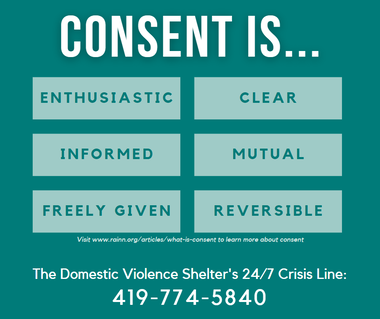|
April is Sexual Assault Awareness Month. Sexual assault is any type of sexual contact without consent. Exact legal definitions of consent my vary by location and circumstance but general concept is always the same- giving permission for something to happen. While consent is an essential part of sexual contact, consent is also part of our everyday reactions. Consent is about respecting other people's boundaries. By practicing consent in everyday situations, you are showing respect for them and respecting their right to make decisions for themselves. Understanding ConsentConsent is a conversation. It involves one person asking a question and the other person giving an answer. Just like other types of communication, consent involves spoken words, body language, non-verbal cues and personal interpretation. So how can you be sure that you have been given consent? Consent only occurs when it's enthusiastic, clear, informed, mutual, freely given and reversible. Enthusiastic: Consent is not just the absence of "no". Your partner should give you a clear yes. If you are not sure, just ask! Your partner's body language and non-verbal cues should also express that they are happy with their decision. Clear: You should explain exactly what you would like to happen. Make sure your partner understands exactly what you are asking. Both partners should communicate any questions or concerns and ensure that there is no misunderstandings. Informed: Consent can't occur if someone is not able to make an informed decision. So if someone is vulnerable, such as being intoxicated or unconscious, they are not capable of giving consent. Mutual: Consent is a 2 way street! Both partners should be able to express their boundaries and have their boundaries respected. Freely Given: You can't give consent if you are afraid to say no. If you are afraid of being physically harmed or if you are afraid of retaliation if you say no, you are not giving consent. Coercion is also not consent! Reversible: Anyone can change their mind, at any time! No is a full sentence. Once someone says "no". You must stop what you are doing immediately. We Practice Consent EverydayPeople often think the term consent refers only to intimacy and sex, but it is also a useful way to think about other kinds of boundaries-with everyone, every day and in every situation. We practice consent so often that we likely don't even recognize these situations! Here's some examples of everyday consent. Learn More About ConsentTo learn more about consent, check out the resources used to create this blog. You can also call The Domestic Violence Shelter's 24/7 Crisis Line at 419-774-5840.
https://www.teenvogue.com/story/consent-how-to https://www.rainn.org/articles/what-is-consent https://www.plannedparenthood.org/learn/relationships/sexual-consent https://www.nsvrc.org/sites/default/files/2018-01/everydayconsent_onepager_508.pdf https://www.loveisrespect.org/resources/what-consent-does-and-doesnt-look-like/
0 Comments
Leave a Reply. |



 RSS Feed
RSS Feed
